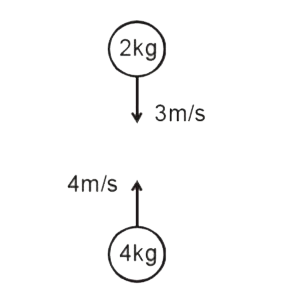A completely inelastic collision occurs between two balls of wet putty that move directly toward each other along a vertical axis. Just before the collision, one ball, of mass 3.0 kg, is moving upward at 20 m/s and the other ball, of mass 2.0 kg, is moving downward at 12 m/s. How high do the combined two balls of putty rise above the collision point? (Neglect air drag.)
2.3 m
2.0 m
2.6 m
2.9 m
The correct Answer is:C
To solve the problem step by step, we will follow these main steps:
Step 1: Calculate the initial momentum of both balls before the collision.
The momentum of an object is given by the formula:
p=m⋅v
Where:
- p is momentum,
- m is mass,
- v is velocity.
For the first ball (mass = 3.0 kg, velocity = 20 m/s upward):
p1=3.0kg⋅20m/s=60kg m/s
For the second ball (mass = 2.0 kg, velocity = -12 m/s downward):
p2=2.0kg⋅(−12m/s)=−24kg m/s
Step 2: Calculate the total initial momentum before the collision.
The total initial momentum pinitial is the sum of the momenta of both balls:
pinitial=p1+p2=60kg m/s−24kg m/s=36kg m/s
Step 3: Calculate the combined mass after the collision.
After a completely inelastic collision, the two balls stick together. The total mass mtotal is:
mtotal=m1+m2=3.0kg+2.0kg=5.0kg
Step 4: Calculate the velocity of the combined mass after the collision using conservation of momentum.
Using the conservation of momentum:
pinitial=pfinal
Where:
pfinal=mtotal⋅V
Thus,
36kg m/s=5.0kg⋅V
Solving for V:
V=36kg m/s5.0kg=7.2m/s
Step 5: Calculate the maximum height reached after the collision.
To find the height h that the combined mass rises, we can use the kinematic equation:
V2=U2+2ah
Where:
- V=0 (final velocity at the maximum height),
- U=7.2m/s (initial velocity after collision),
- a=−9.8m/s2 (acceleration due to gravity, negative as it acts downward).
Rearranging the equation to solve for h:
0=(7.2)2+2(−9.8)h
0=51.84−19.6h
19.6h=51.84
h=51.8419.6≈2.64m
Final Answer:
The combined two balls of putty rise approximately 2.64 meters above the collision point.
---
The momentum of an object is given by the formula:
p=m⋅v
Where:
- p is momentum,
- m is mass,
- v is velocity.
p1=3.0kg⋅20m/s=60kg m/s
p2=2.0kg⋅(−12m/s)=−24kg m/s
The total initial momentum pinitial is the sum of the momenta of both balls:
pinitial=p1+p2=60kg m/s−24kg m/s=36kg m/s
After a completely inelastic collision, the two balls stick together. The total mass mtotal is:
mtotal=m1+m2=3.0kg+2.0kg=5.0kg
Using the conservation of momentum:
pinitial=pfinal
Where:
pfinal=mtotal⋅V
Thus,
36kg m/s=5.0kg⋅V
Solving for V:
V=36kg m/s5.0kg=7.2m/s
To find the height h that the combined mass rises, we can use the kinematic equation:
V2=U2+2ah
Where:
- V=0 (final velocity at the maximum height),
- U=7.2m/s (initial velocity after collision),
- a=−9.8m/s2 (acceleration due to gravity, negative as it acts downward).
0=(7.2)2+2(−9.8)h
0=51.84−19.6h
19.6h=51.84
h=51.8419.6≈2.64m
The combined two balls of putty rise approximately 2.64 meters above the collision point.
Topper's Solved these Questions
- BOOK - RESNICK AND HALLIDAYCHAPTER - CENTER OF MASS EXERCISE - Practice Questions (More than One Correct Choice)5videos
CENTER OF MASS
- BOOK - RESNICK AND HALLIDAYCHAPTER - CENTER OF MASS EXERCISE - Practice Questions (Linked Comprehension)6videos
CENTER OF MASS
- BOOK - RESNICK AND HALLIDAYCHAPTER - CENTER OF MASS EXERCISE - Problems46videos
CENTER OF MASS
- BOOK - RESNICK AND HALLIDAYCHAPTER - CAPACITANCEEXERCISE - PRACTICE QUESTION (INTEGER TYPE)3videos
CAPACITANCE
- BOOK - RESNICK AND HALLIDAYCHAPTER - CIRCUITSEXERCISE - Practice Questions (Integer Type)3videos
CIRCUITS
Similar Questions
A completely inelastic collision occurs between two balls of wet putty that move directly toward cach other along a vertical axis. Just before the collision, one ball, of mass 3.0 kg, is moving upward at 20 m/s and the other ball, of mass 2.0 kg, is moving downward at 10 m/s. How high do the combined two balls of putty rise above the collision point? (Neglect air drag.)
View SolutionA ball of mass 1kg moving with 4m−1 along +x-axis collides elastically with an another ball of mass 2kg moving with 6m/s is opposite direction. Find their velocities after collision.
View Solution
Knowledge Check
- Question 1 - Select One
A ball of mass 10 kg is moving with a velocity of 10 m / s . It strikes another ball of mass 5 kg which is moving in the same direction with a velocity of 4 m / s . If the collision is elastic, their velocities after the collision will be, respectively
A6m/s, 12m/sB12m/s, 6m/sC12 m/s, 10 m/sD12m/s, 25m/s
A ball of mass 100g moving at a speed of 12 m s−1 strikes another ball of mass 200 g at rest. After the collision both the balls move with a common velocity. Find the common velocity.
View SolutionA ball of mass 100g moving at a speed of 12 m s−1 strikes another ball of mass 200 g at rest. After the collision both the balls move with a common velocity. Find the common velocity.
View SolutionA ball of mass 5 kg moving velocity 3m/s impinges direction on another ball of mass 2 kg moving with velocity 0.5m/s towards the first ball. Find the velocity after impact, if e=47
View SolutionA ball of mass 100g moving at a speed of 12 m s−1 strikes another ball of mass 200 g at rest. After the collision both the balls stick to each other and move with a common velocity. Find the common velocity.
View SolutionTwo balls are moving towards each other on a vertical line collides with each other as shown. Find their velocities just after collision.
 View Solution
View SolutionA ball of mass 100g moving at a speed of 12 m s−1 strikes another ball of mass 200 g at rest. After the collision both the balls stick to each other and move with a common velocity. Find the common velocity.
View SolutionA ball of mass 0.50 kg moving at a speed of 5.0 m/s collides with another ball of mas 1.0 kg. After the collision the balls stick together ane remain motionless. What was the velocity of the 1.0 kg block before the collision?
View Solution

